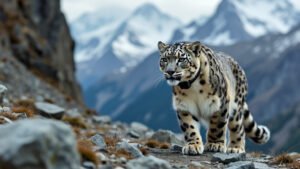Introduction
The integration of genetic research into snow leopard conservation is transforming the way scientists and conservationists protect this elusive species. By unlocking the secrets of DNA, researchers are able to track populations more accurately, enhance breeding programs, and identify critical habitats
This article will explore how genetic markers are used to monitor snow leopard populations, the role of genetics in breeding programs, the impact of genetic insights on habitat conservation, and the challenges faced in using genetic data. Understanding these aspects is crucial for ensuring the survival of snow leopards in the wild
How Genetic Research Helps Track Snow Leopard Populations
Genetic research has become an indispensable tool in tracking and monitoring snow leopard populations. Traditional tracking methods, such as camera traps and radio collars, provide valuable data, but they are often limited by the elusive nature of snow leopards and the rugged terrain they inhabit
Genetic research offers a more comprehensive and less invasive approach, enabling scientists to gather critical information about population size, distribution, and connectivity. By analyzing DNA samples from feces, fur, or even environmental DNA (eDNA) in snow and water, researchers can gain insights that would otherwise be impossible to obtain
Importance of Genetic Markers in Population Tracking
Genetic markers play a crucial role in the study of snow leopard populations. These markers, which are specific sequences of DNA, allow scientists to identify individual leopards and assess genetic diversity within a population
By analyzing these markers, researchers can estimate population sizes, track movement patterns, and even determine relationships between different groups of snow leopards. This information is vital for understanding the dynamics of snow leopard populations, especially in fragmented habitats where genetic diversity might be at risk
One of the key techniques used in this area is microsatellite analysis, which involves examining short, repeated sequences of DNA that are highly variable between individuals
Microsatellite markers are particularly useful for distinguishing between closely related individuals, making them ideal for tracking snow leopards in the wild. For example, a study conducted in the Altai Mountains of Russia utilized microsatellite markers to estimate the population size and structure of snow leopards in the region, providing critical data for conservation efforts
Case Studies of Successful Tracking Using Genetics
Several successful case studies demonstrate the power of genetic research in tracking snow leopards. In Nepal, for instance, researchers used non-invasive genetic sampling to estimate the population size of snow leopards in the Annapurna Conservation Area
By collecting and analyzing DNA from fecal samples, the team was able to identify individual leopards and estimate the total population size, providing a baseline for future conservation work
Another significant study took place in the Tost Mountains of Mongolia, where scientists used genetic analysis to track the movements of snow leopards across a large landscape
This research revealed important information about the connectivity between different snow leopard populations, which is crucial for maintaining genetic diversity and ensuring the long-term survival of the species. The findings from this study have informed conservation strategies that aim to protect key corridors used by snow leopards for migration and dispersal
Techniques for Collecting Genetic Samples in the Wild
Collecting genetic samples from snow leopards presents unique challenges due to their elusive nature and the harsh environments they inhabit. However, advancements in field techniques have made it possible to gather high-quality samples without disturbing the animals
Non-invasive methods, such as collecting feces, hair, or urine, are commonly used. Fecal samples are particularly valuable as they contain DNA from the snow leopard’s diet, which can provide additional information about their prey species and dietary habits
Environmental DNA (eDNA) is another innovative approach that involves collecting DNA from environmental samples like snow or water. This method allows researchers to detect the presence of snow leopards in an area without needing to find direct physical evidence of the animals
For example, eDNA has been successfully used in the Himalayas to confirm the presence of snow leopards in remote areas, contributing to a more accurate understanding of their distribution
In some cases, genetic material can also be obtained from blood samples, particularly when snow leopards are captured for tagging or medical treatment. While this method is more invasive, it provides high-quality DNA that can be used for detailed genetic studies, such as whole-genome sequencing
The choice of sampling method depends on the specific goals of the research and the logistical constraints of working in remote, mountainous regions
Role of Genetics in Snow Leopard Breeding Programs
Breeding programs play a crucial role in the conservation of snow leopards, particularly for maintaining and enhancing their genetic diversity
Genetics is integral to these programs, as it provides the data needed to select mates that will maximize genetic variation and reduce the risks associated with inbreeding. By leveraging genetic insights, conservationists can ensure that captive populations of snow leopards remain healthy and viable, ultimately supporting the long-term survival of the species in the wild
This section explores how genetics influences mate selection, the role it plays in avoiding inbreeding, and the successes achieved through genetically informed breeding strategies
Selecting Genetically Diverse Mates for Captive Breeding
In captive breeding programs, the selection of mates is one of the most critical decisions for ensuring the genetic health of the population. Genetic diversity is essential for a population’s ability to adapt to changing environments and resist diseases
In snow leopard breeding programs, conservationists use genetic data to assess the genetic makeup of individual animals and select breeding pairs that are as genetically diverse as possible
To achieve this, researchers often rely on techniques such as pedigree analysis and genetic screening. Pedigree analysis involves tracking the ancestry of individual snow leopards to avoid breeding closely related animals, while genetic screening uses DNA testing to measure the genetic variability between potential mates. The goal is to produce offspring with a broad genetic base, which can enhance their fitness and resilience
For example, the Snow Leopard Trust, an organization dedicated to the conservation of snow leopards, uses genetic data to guide breeding decisions in both captive and semi-wild populations. By prioritizing genetic diversity in their breeding strategies, they aim to create a robust genetic pool that can support reintroduction efforts and bolster wild populations
The Role of Genetics in Avoiding Inbreeding
Inbreeding, or the mating of closely related individuals, poses a significant risk to the genetic health of snow leopards, particularly in small or isolated populations
Inbreeding can lead to a loss of genetic diversity and increase the likelihood of genetic disorders, which can reduce the overall fitness and survival rates of the species. In captive breeding programs, genetics plays a vital role in preventing inbreeding and its associated risks
Geneticists working with snow leopard populations use tools such as genetic distance calculations and inbreeding coefficients to monitor and manage genetic relationships within the population
These tools help conservationists identify which individuals should not be bred together due to their genetic similarity. By carefully managing the genetic relationships within the breeding population, conservationists can minimize the risk of inbreeding depression, a phenomenon where inbred populations suffer from reduced fertility, higher mortality rates, and increased susceptibility to diseases
One example of this approach is the Global Species Management Plan (GSMP) for snow leopards, which coordinates breeding efforts across zoos and wildlife parks worldwide
The GSMP uses genetic data to make informed decisions about breeding pairs, ensuring that the global captive population remains genetically diverse and healthy. This program has been instrumental in preventing inbreeding and maintaining a strong genetic foundation for future generations of snow leopards
Success Stories in Captive Breeding Programs
The use of genetics in snow leopard breeding programs has led to several notable successes. One such example is the breeding program at the Nordens Ark wildlife park in Sweden, where genetic data has been used to guide the selection of breeding pairs
By focusing on genetic diversity, the program has successfully produced a number of healthy snow leopard cubs that contribute to the global gene pool. These cubs are often candidates for reintroduction programs, where their diverse genetic backgrounds can help bolster wild populations
Another success story comes from the Central Zoo Authority in India, which has implemented a genetic management program for snow leopards in Indian zoos. This program, which includes genetic testing and careful monitoring of breeding pairs, has led to the birth of genetically healthy cubs and has helped maintain the genetic integrity of the captive snow leopard population in India
These successes demonstrate the power of genetics in improving the outcomes of captive breeding programs. By continuing to apply genetic research in these programs, conservationists can ensure that captive snow leopard populations remain a vital resource for the long-term conservation of the species
Improving Habitat Conservation Through Genetic Insights
Genetic research offers invaluable insights that go beyond the boundaries of individual snow leopards, extending to the preservation of their habitats
By understanding the genetic diversity and population structure of snow leopards, conservationists can identify critical habitats, predict future habitat needs, and integrate this knowledge into broader conservation strategies
This section will delve into how genetics is used to pinpoint essential habitats, forecast habitat changes, and inform conservation plans that ensure the long-term survival of snow leopards in the wild
Identifying Critical Habitats Using Genetic Data
Genetic data provides a unique perspective on snow leopard populations, particularly in identifying critical habitats that are essential for their survival
Through the analysis of genetic variation across different regions, researchers can determine areas where snow leopards are most genetically diverse or where specific populations are at risk of becoming isolated. This information is crucial for prioritizing conservation efforts in habitats that are vital for maintaining healthy, connected populations
One method used to identify these critical habitats is landscape genetics, which combines genetic data with geographical information to understand how landscape features influence gene flow among populations
For instance, a study in the Pamir Mountains used landscape genetics to reveal that certain mountain passes and valleys serve as crucial corridors for snow leopard movement, connecting otherwise isolated populations. Protecting these corridors is essential for maintaining genetic diversity and preventing inbreeding, which can occur when populations become too isolated
Another approach is the use of genetic hotspots, areas where genetic diversity is particularly high or where unique genetic lineages are found. These hotspots often coincide with regions of high biodiversity and are critical for the long-term survival of snow leopards and other species
Conservation efforts focused on protecting these genetic hotspots can help preserve the evolutionary potential of snow leopards, allowing them to adapt to future environmental changes
How Genetics Can Predict Future Habitat Needs
Climate change and human activities are rapidly altering the landscapes that snow leopards call home, making it increasingly important to predict how their habitats will change in the future
Genetics can play a key role in this by helping researchers understand how snow leopards have historically responded to environmental changes and by identifying genetic traits that may influence their ability to adapt to new conditions
For example, researchers can study the genetic signatures of past population bottlenecks, where snow leopard populations may have drastically declined due to environmental changes. By understanding how these populations recovered and what genetic traits were associated with survival, conservationists can make informed predictions about how current and future snow leopard populations might respond to similar pressures
Additionally, genetic studies can help identify populations that are particularly vulnerable to climate change. Populations with low genetic diversity or those that are already living in marginal habitats may be at greater risk as temperatures rise and prey availability shifts
By pinpointing these at-risk populations, conservationists can focus their efforts on enhancing habitat connectivity or even consider translocating individuals to more suitable habitats to ensure their survival
Integrating Genetic Research into Habitat Protection Plans
Integrating genetic insights into habitat protection plans is a growing priority in snow leopard conservation. By using genetic data to inform decisions about where to establish protected areas or how to manage existing ones, conservationists can ensure that these efforts are more effective and sustainable in the long term
For example, conservationists working in Central Asia have used genetic data to guide the establishment of new protected areas that encompass key genetic corridors and breeding grounds for snow leopards
These protected areas are designed not only to preserve the existing populations but also to facilitate gene flow between populations, which is essential for maintaining genetic diversity and resilience
Moreover, genetic research can inform land-use planning and development policies in regions where snow leopards are found. By identifying areas that are critical for snow leopard survival, conservationists can work with local governments and communities to minimize habitat fragmentation and human-wildlife conflict
This holistic approach, which considers both genetic data and socio-economic factors, is essential for creating conservation strategies that are both scientifically sound and socially acceptable
Addressing Genetic Challenges in Snow Leopard Conservation
While genetic research has greatly advanced snow leopard conservation, it is not without its challenges. Issues such as limited genetic diversity, difficulties in collecting genetic data, and ethical considerations pose significant obstacles that conservationists must navigate
This section explores these challenges, discussing the implications of low genetic diversity, the hurdles in obtaining and analyzing genetic samples, and the ethical dilemmas that arise in the application of genetic research for conservation
Limited Genetic Diversity and Its Impact
Limited genetic diversity is a major concern in snow leopard conservation, particularly for populations that are small or isolated
Genetic diversity is crucial for a species’ ability to adapt to environmental changes and resist diseases. Low genetic diversity can lead to inbreeding, which increases the risk of genetic disorders and reduces overall population fitness
In snow leopards, genetic studies have shown that certain populations, especially those in fragmented habitats, exhibit lower genetic diversity compared to more connected populations. This lack of diversity can have serious consequences for their long-term survival
For instance, inbreeding depression can result in reduced reproductive success and higher infant mortality, both of which threaten the viability of small populations
Efforts to address this issue often involve enhancing gene flow between isolated populations. One approach is to create or maintain wildlife corridors that allow snow leopards to move between different areas, thus facilitating natural gene exchange
In some cases, conservationists may consider translocating individuals from genetically diverse populations to bolster the genetic pool of smaller, isolated groups. However, these strategies come with their own set of challenges and risks, requiring careful planning and monitoring to ensure they do not inadvertently harm the populations they are meant to help
Overcoming the Challenges of Collecting Genetic Data
Collecting genetic data from snow leopards is fraught with challenges due to the species’ elusive nature and the rugged, remote environments they inhabit
Traditional methods of obtaining genetic material, such as capturing and sampling blood, are often impractical and stressful for the animals. As a result, conservationists have increasingly turned to non-invasive methods like collecting feces, fur, or environmental DNA (eDNA) from snow, water, or soil
While non-invasive sampling methods reduce the stress on snow leopards and are more feasible in remote areas, they present their own difficulties
For example, fecal samples can be degraded by environmental factors like sunlight, moisture, and temperature, which can reduce the quality and quantity of DNA extracted. Additionally, identifying individual animals from these samples can be challenging, especially in areas where multiple snow leopards may roam
To overcome these obstacles, researchers have developed advanced techniques for DNA extraction and analysis. One such technique is the use of polymerase chain reaction (PCR) to amplify small quantities of DNA, making it possible to obtain reliable genetic data from even the most degraded samples
Furthermore, improvements in sequencing technology have enabled the analysis of entire genomes from small DNA samples, providing more comprehensive insights into snow leopard genetics
Despite these advancements, the logistical challenges of collecting and transporting samples from remote areas remain significant. Weather conditions, difficult terrain, and limited access to laboratories can all delay or complicate genetic analysis
To address these issues, some conservation projects have established field-based laboratories or mobile units equipped with the necessary tools for on-site DNA extraction and analysis, reducing the time between sample collection and data acquisition
Ethical Considerations in Genetic Research for Conservation
The application of genetic research in snow leopard conservation raises important ethical questions that must be carefully considered. One key concern is the potential impact of genetic interventions on the natural behavior and evolutionary processes of snow leopards
For example, translocating individuals to enhance genetic diversity may inadvertently disrupt local populations or lead to the introduction of maladaptive traits that could harm the species in the long term
Another ethical issue is the potential for genetic data to be misused. For instance, genetic information that identifies rare or unique populations could be exploited by poachers or illegal wildlife traders. Ensuring that genetic data is securely stored and only shared with trusted partners is crucial to preventing such misuse
Additionally, the collection of genetic samples, even when non-invasive, must be conducted with respect for the animals and their habitats
This includes minimizing disturbance to snow leopards and their prey, as well as ensuring that research activities do not negatively impact the broader ecosystem. Conservationists must also consider the rights and interests of local communities who share the landscape with snow leopards
Involving these communities in genetic research and ensuring they benefit from conservation efforts can help address potential ethical conflicts
To navigate these ethical challenges, many conservation organizations adhere to strict ethical guidelines and seek the input of bioethicists and local stakeholders when designing and implementing genetic research projects. This collaborative approach helps ensure that genetic research contributes positively to snow leopard conservation while respecting the species and its environment
Conclusion
Genetic research has proven to be a transformative tool in the conservation of snow leopards, offering new insights and solutions to the challenges faced by this elusive species. By enabling more accurate tracking of populations, informing breeding programs, and guiding habitat conservation efforts, genetics has become integral to the survival strategy for snow leopards
However, this field is not without its challenges, including issues related to limited genetic diversity, the difficulties of collecting genetic data in remote and harsh environments, and the ethical considerations that arise from genetic interventions
Despite these hurdles, the ongoing application of genetic research continues to enhance our understanding and ability to protect snow leopards. As we look to the future, integrating these genetic insights into broader conservation strategies will be crucial for ensuring that snow leopards thrive in the wild for generations to come










